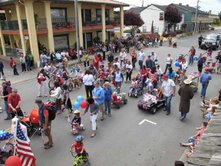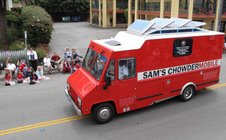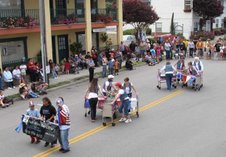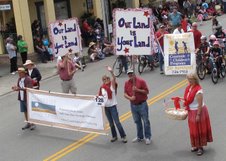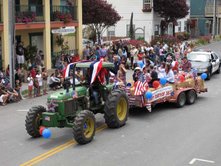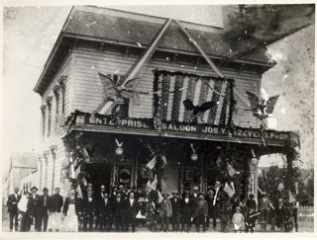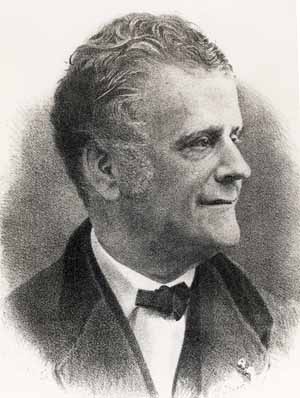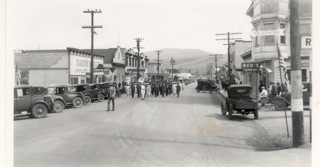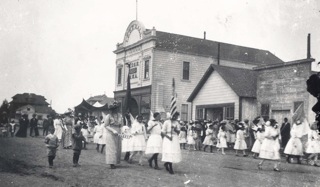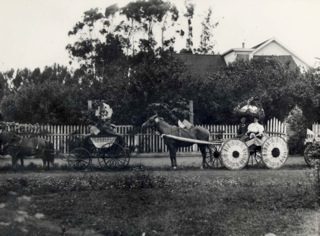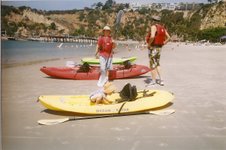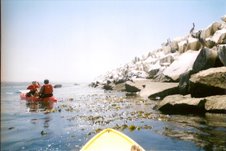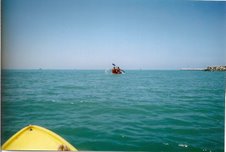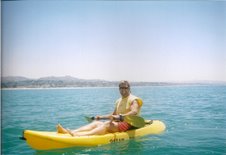Story from John Vonderlin
Email John ([email protected])
West Shore Railway, Chapter 1
Hi June,
This July 19th, 1895 article in the “Call,” spun
one more set of dreams about a coast railroad.
This one was a sure success. Ask them, they’ll
tell you. I just wonder if it’s too late to get in on it?
Enjoy. John
RAILS TO SPANISHTOWN.
The New West Shore Railroad
Company Will Want
Central Basin.
Glimpses of the Project for a Railroad Down the Coast to
Santa Cruz.
The new West Shore Railway Company, which announces its purpose to promptly build a railroad from San Francisco down
the line of breakers, through Halfmoon Bay and Pescadero, to Santa Cruz, is athing of real interest.
The new railroad company, which filed articles of incorporation last Friday, says that it is going to build that road at once.
The company is yet playing in the dark, and the directors will afford only glimpses of their plans and expectations. Those who signed the articles of incorporation are: C. M. Sanger, Behrend Joost. R. S. Thornton, J. W. Eisenfurth, Louis F. Dunand, K. J. Willets and R. Herman. At an election yesterday the first five named were elected respectively president, vice president, treasurer, secretary and attorney of the company.
At the office of Mr. Eisenfurth, the captalist, in the Crocker building, President Sanger, Vice-President Behrend Joost and a good-looking business lady were seenyesterday. The lady seemed to know more about the road than anybody, and to be the most discreet in reserving information.
Mr. Joost and Mr. Sanger joined in making the statement:
The road will positively be built. We will begin work in sixty days and part of the material is already here. We don’t want to say just what the “material is, nor just where the road will run, nor much about our business, for we don’t want to show our hand, nor the
route, nor anything of the kind at this moment. We are going ahead and keeping out of the papers.
The company was incorporated as the San Francisco and West Shore Railway Company, but the San Francisco was officially lopped off yesterday.
Mr. Sanger went home and Mr. Joost and the business lady dropped intimations which showed that the company’s plans
are to enter the City limits near Colma, probably swinging in from the ocean by way of the San Pedro Valley and a tunnel, and then circling round the San Bruno hills and reaching the water front at about Central Basin, in the neighborhood of the Potrero. To this terminal ferry-boats are to be run from the business part of the
City.
“We will probably ask for a lease of Central Basin similar to the lease given the Valley road,” said Mr. Joost, “and there will also be another branch connecting with the City by another route. No, the San Mateo electric road has no connection with it. We will run ferry-boats, I am willing to say.”
The capital stock of the company is fixed at $2,000,000, of which the amount required by law is subscribed. The South Pacific Coast narrow-gauge road sold for $6,000,000.
“No,” said Mr. Joost, “the road cannot be built for $2,000,000, but the amount of stock is placed at a low figure because we want to pay dividends right away and none of the stock is for sale. The money is arranged for, but I am not at liberty tosay where it will come from. Well, it will be both San Francisco and Eastern money.
It is all arranged. We don’t want to say much just now because we don’t want people to gamble on where we will go.”
It was told that most of those interested had been working up the project for three years and that the company has the rates and estimates of three surveys made in the past. One of them. Mr. Joost said, was made by Jay Gould’s direction several years ago, when he was interested in the Santa Fe road.
“Stakes are set every foot of the way,” said Mr. Joost.
The line will not be a very expensive one to build, Mr. Joost says. After getting through and across the range of tangled hills that turns into bluffs about Mussel Rocks on the shore, most of the way will be along comparatively level valleys that slope to the sea. The line will follow the shore, and for superb scenic attractions will offer the ocean on one side and mountains, redwood forests and fruitful valleys on the other. The distance by this route to Santa Cruz will be only seventy miles, and the great shortening of time to theLong Branch of the Pacific Coast is counted on as an immense advantage in the competition for passenger traffic.
The ideas of the promoters is that such a railroad would at once popularize and populate Halfmoon Bay, Pescadero and other places as summer resorts. These places nave been famous in that way for years, but have been enjoyed only by visitors who were willing to make a very long, though charming trip, by stage over the mountains.
The business inducements offered to a railroad by this stretch of rich and peculiar country are fully reckoned upon by these
railroad people. They have been presented in newspapers in inviting waysmany times in many years.
Just over the crest of the hills south of Colma is the San Pedro Valley from which great four-horse teams nightly draw great
loads of vegetables to the San Francisco markets and to the box-cars which daily leave Colma for the East carrying those cabbages and cauliflowers to Chicago andKansas City. A railroad would cheapen this transportation, gain a considerable revenue and stimulate gardening industry all through that region where the foggy moisture of the sea and the richness of the soil are peculiarly kind to the green thingssold in the market places.
For fifty miles the dairy industry is extensive and waiting the stimulation a railroad would give. There are great redwood
forests close along the route, and deposits of bitumen, limestone and other minerals.
Mr. Joost says that the company will run spur tracks back into the valleys among the farms, dairies and forests and operate them with electricity ground out by mountain streams.
The company will ask for bonuses and other aids as well as franchises and water front privileges as soon as it gets ready for
practical operations.
=======================
West Shore Railway, Part II
Hi June,
Here’s another chapter in the West Shore Railroad Company’s plan. I’m going to ask the experts how this route differs from the one the OSR followed. They seem so sure of success in this article, I’m curious what happened to these “best laid plans.” Maybe Angelo or John can tell us. This article was in the March 11th, 1894 “Morning Call.” Enjoy. John
THE WEST SHORE.
Work Commenced on the
New Road.
FIRST DIRT TURNED FRIDAY.
It Will Penetrate a Splendid
Section of Country.
NEW ROUTE FULLY OUTLINED.
Nothing New in the Railroad War
Except That the Presidents Now
Have It in Hand.
San Francisco is to have a new railroad line, not one of those fragile creatures which exist only upon paper, but a railroad
in fact, and one that will traverse some of the best lands in the State, and which will afford its patrons as picturesque scenery
as is to be viewed in California.
The road referred to is tbe San Francisco and West Shore, which will at present be built from this city to Halfmoon Bay, a distance of forty miles, but which it is contemplated will be extended further at no distant day.
Work was actively begun Thursday, when a large force of men were placed at grading and similar occupation, at and near Point San Pedro Signal station, and it is expected to prosecute the labor with vigor.
The gentlemen who have this important enterprise in charge have met with many difficulties in tbeir efforts to push the pro-
ject through, and although they have achieved a sufficient degree of success in their plans to warrant them in beginning work there are yet many details of the matter in an embryo condition.
The starting point ot the road in this city— is the place at which the passenger station will be located— is at Twenty-fifth street and Potrero avenue, butthere is a branch which will run out to the
company’s freight wharf, which will be erected adjoining Spreckels’ sugar refinery on the bay. The freight branch will runalong Sonoma street to Minnesota, thence cutting across in a southwesterly direction to the junction of Loomis street and Barneveld avenue, where it will connect with tbe main line.
The latter, in its route from the terminal first named— Twenty-fifth street and Potrero avenue follows the survey along Barneveld avenue and through private property to Dickerson street, thence on through private property to Case street, thence folllowing Islais and Channel to the Mission-street road, south of St. Mary’s College, and passing under that road through a tunnel 150 feet long. From this tunnel on to Ocean View the channel of the same creek is followed, and Ocean View itself, and the Southern Pacihc track will also be tunneled by a passageway 3200 feet long, which will admit the road to the property of the Spring Valley Water Company, following it to Lake Merced. From this point tbe line will run on the south west side of the lake to Ocean Point, thence along the bluffs and table lands, 200 feet above the ocean, to Mussel Rocks, then swinging into the valley and following it to Salt Lake, located near tbe ocean, and going under McGinty’s Pass by a tunnel 250 feet long, which will give the road admission into the famous San Pedro Valley, which it skirts for a distance of several miles.
At this point is San Pedro Cove, which promises one of tbe finest beaches for bathing and similar purposes to be found in the West. The locality is only sixteen miles from the city, and is in one of the
most fertile valleys in the State. Many streams run through the district, which literally abound with trout, and it is a favorite resort for people who go down there to camp in the summer.
This valley is also famous as a vegetable producing locality, many thousand acres being devoted to this purpose and on which five crops are frequently raised in one year. Land used for this purpose, it is said, pays a rental of $10 a year peracre. There are plenty of fruits back in the hills, and the county is also noted for
the number of dairies successfully conducted there.
Lake Mathilda, a large body of fresh water on the Tobin estate, is also a great place for trout-fishing, and in fact the new road promises to open up a territory which will be a great favorite with sportsmen.
After leaving San Pedro Valley tbe road will strike San Pedro Point No. 1, passing through a tunnel 1300 feet long out upon
the bluffs 210 feet above the ocean, and on to San Pedro Point No. 2. through which another tunnel 600 feet long will be driven.
Again the valley lands will be entered which lead on to Point Montara, where the United States fog signal is located, and
running behind this the road will reach the table lands which it will follow for a short distance and then swing back into the valley to Half moon Bay, which it will skirt for about eight miles until it reaches the temporary terminus at Spanishtown.
There were no new developments in the railroad rate war yesterday aside from the statement made at the Southern Pacitic
general office tbat the trouble had now passed into the hands of the two presidents of the contending roads.
It is rumored tbat as soon as the heavy work on tbe road between San Luis Obispo and Santa Margarita is finished the Southern Pacific Company will straighten its line out of this city from Fourth and Townsend streets through to the stockyards in South San Francisco, thus avoiding the big curve now made in the line
running out by way of Valencia . street, and running almost directly south from the depot. This will necessitate the tunneling of tbe big hill just this side of the stockyards.
=============================

